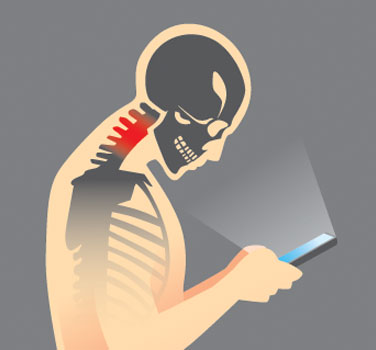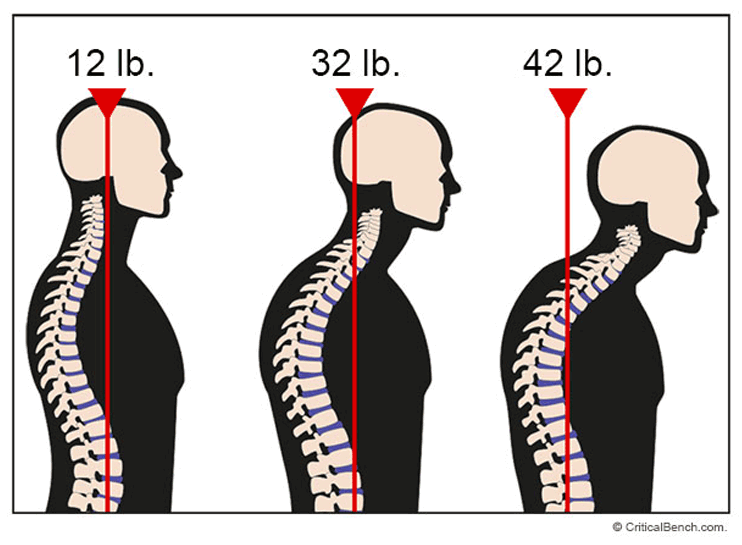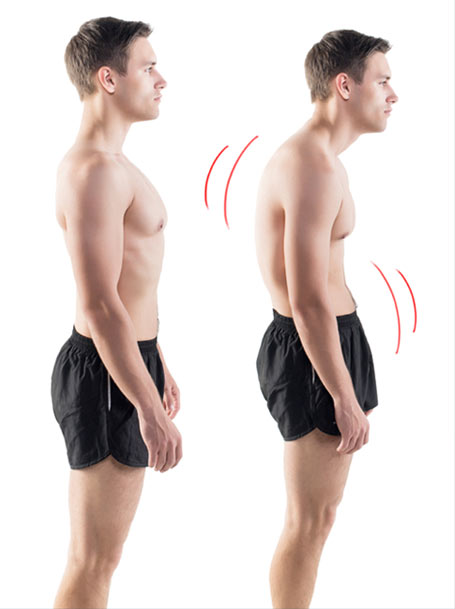Text Neck – Symptoms and treatment
- Text Neck is very common now a days specially in young People
- Consistently looking down at your phone increases stress on the spine and causes Text Neck
- The US researchers warn this could affect a whole generation – and generations to come
So what exactly is Text Neck ?
Text Neck is new name for forward head posture. If not treated in time it may become irreparable and can cause Permanent damage to your neck, back and shoulders…. for the rest of your life .
Some patients, particularly young patients who shouldn’t yet have back and neck issues, are reporting disk hernias and alignment problems, the study authors write in The Spine Journal.
‘In an X-ray, the neck typically curves backward, and what we’re seeing is that the curve is being reversed as people look down at their phones for hours each day,
‘By the time patients get to me, they’re already in bad pain and have disc issues,’ he told Reuters Health.
Some patients, particularly young patients who shouldn’t yet have back and neck issues, are reporting disk hernias and alignment problems due to texting, researchers warn
‘The real concern is that we don’t know what this means down the road for kids today who use phones all day.’
An orthopedic spine surgeon at Cedars-Sinai, write that people often look down when using their smartphones, particularly when texting as compared to browsing online or watching videos.
Previous studies have also found that people hold their necks at around 45 degrees, and it becomes even worse as they sit, versus standing, the study team writes.
The impact on the spine increases at higher flexed postures, they add.
While in a neutral position looking forward, the head weighs about 10 to 12 pounds.
At a 15-degree flex, it feels like 27 pounds. The stress on the spine increases by degree, and at 60 degrees, it’s 60 pounds.
‘For today’s users, will an 8-year-old need surgery at age 28?’ Lanman said. ‘In kids who have spines that are still growing and not developed, we’re not sure what to expect or if this could change normal anatomies,’ he told Reuters Health.
Lanman and Cuellar suggest simple lifestyle changes to relieve the stress from the ‘text neck’ posture. They recommend holding cell phones in front of the face, or near eye level, while texting.
They also suggest using two hands and two thumbs to create a more symmetrical and comfortable position for the spine.
Beyond smartphone use, the spinal surgeons recommend that people who work at computers or on tablets use an elevated monitor stand so it sits at a natural horizontal eye level.
With laptops, they recommend a similar adaptation by using a separate keyboard and mouse so the laptop can be at eye level and still create a good ergonomic position while typing.
TEXTING NECK OR FORWARD HEAD POSTURE IS DESTROYING YOUR HEALTH
OFFICE GUY SYNDROME
It’s like the old man’s hunch curving your body forward with your shoulders dropped making you look weak, submissive and shorter than you really are.
The curve of your neck and back means you may drop height by a couple of inches and look a lot older than you are.
‘It is difficult to recommend a proper posture for smartphone users. If we raise the phone at eye level to avoid the look-down posture, it will add new concerns for the shoulder due to the elevated arm posture.
‘A more practical recommendation would be frequent rest breaks or some physical exercise that can strengthen the neck and shoulder muscles,’ Shin told Reuters Health.
‘Some apps can give alarming signals to users to avoid prolonged looking-down posture.’
Lanman recommends stretches and basic exercises that focus on posture as well. He tells patients to lie on their beds and hang their heads over the edge, extending the neck backward to restore the normal arc in the neck.
While sitting, he recommends aligning the neck and spine by checking that the ears are over the shoulders and the shoulders are over the hips.
‘Ask your friend to take a photo of your upper body when you’re texting, then use the picture as the background image on your phone,’ Shin said.
‘That will remind you to take breaks frequently. Even a short break of a few seconds – called a micro-break – can help our tissues recover.’
Other than bad posture and back ache the other challenges by generation Y is eye problem and Insomnia, thanks to high mobile usage.
One option you can try to mitigate the risk to check this foldable table top mobile holder
YOUR POOR HEAD POSTURE MAKES YOU LOOK HEAVIER AND SHORTER THAN YOU ACTUALLY ARE.
As the main connector between your upper torso and skull, the neck has the crucial task of cradling the body’s computer — the brain.
Not only does Forward Head Posture give your back that ugly hunch and crouched-over look… it also causes much deeper, serious problems including:
- Low energy and tiredness
- Pain in neck, shoulders or upper, lower and middle back
- Permanent damage to your joints, muscles, ligaments, blood vessels & nerves
- Headaches and migraines
- insomnia
- Arthritis
- Impaired athletic performance
- Affects your hormonal health
- Early degeneration of your spine
- Pinched and trapped nerves
- Decreased range of motion
- Lack of confidence
- Decreased lung capacity by up to 30%
- Harmful affects to vision and hearing
- Jaw pain and sinus issues
- Dizziness, vertigo and balance issues
- Burdens your digestive system
If you’ve suffered any of these without realizing the root problem was Forward Head Posture, you’re not alone.
Forward Head Posture or FHP affects nearly everybody, yet hardly anyone understands the serious long-term physical and mental damage it can cause.
And it’s the most important muscle in your neck that dictates just how strong and healthy our posture and well-being is.
Also Read : Too much digitization and television can lead to early old age







